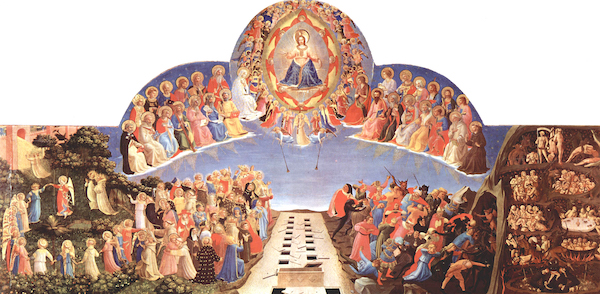How the Church Has Changed the World: A Ring of Joy
- ANTHONY ESOLEN
Fra Angelico (c. 1395-1455) did not dwell in a desert.
Join the worldwide Magnificat family by subscribing now: Your prayer life will never be the same!
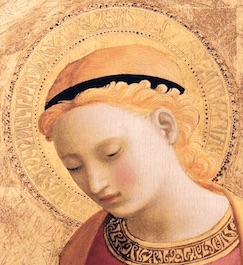 Someone long after we are gone will have to explain why, with all our wealth and sophisticated machinery, our age has wrought so little in the arts to lift up the soul to wonder. Even a spiritual desert can rouse a man to seek the waters. Maybe we dwell in something worse than a desert.
Someone long after we are gone will have to explain why, with all our wealth and sophisticated machinery, our age has wrought so little in the arts to lift up the soul to wonder. Even a spiritual desert can rouse a man to seek the waters. Maybe we dwell in something worse than a desert.
Fra Angelico (c. 1395-1455) did not dwell in a desert. What the Catholic faith wrought in the arts in those days, and in his native Tuscany, is utterly marvelous. Painters whose names we may not even know, and painters of local repute in every little village, and such magnificent artists as Fra Angelico, colored the world with their happy visions. Some of these were sweet and earthy enough, as with the mischievous curly-headed urchins that make for angels by the hand of Fra Filippo Lippi, one of Fra Angelico's followers. But for Fra Angelico, the visions were heavenly, and of earth transformed by heaven.
A child in spirit
Guido di Pietro was born in the little village of Fiesole, atop the mountain overlooking Florence from the east. Like others, he learned his art when he was a boy, though we don't know much about his youth. Sometime in his twenties he joined the Dominicans, and for them he did much of his work, beloved by his brothers for his gentleness and good humor.
Let me illustrate. It was said that Fra Angelico never took the brush unless he prayed first. For each of the cells of his brothers at the convent of Saint Mark in Florence, he painted a fresco of a scene from the Gospel, and it was said that he could not paint the scene of the Passion with out weeping. In 1446, Pope Eugene IV invited him to work in Rome, and while he was there the pope offered to make him Archbishop of Florence. Fra Angelico declined, saying that another friar was far worthier of the honor: the man we honor as Saint Antoninus. One time, Fra Angelico was invited to dinner by Pope Nicholas V, but when he came to the table he didn't know what to do, because he hadn't asked his prior for permission to eat meat. Apparently the pope's permission wasn't enough.
It was said that Fra Angelico never took the brush unless he prayed first.
"He shunned the affairs of the world," says Giorgio Vasari, the great biographer of Italian artists, "and, living a pure and holy life, he was as much the friend of the poor as I believe his soul to be now the friend of heaven." He was sought after, and could command a high price for his work, but he never did. "You have real wealth," he said, "if you are content with little." He could have been an important man in temporal matters, but he said that obedience was less tiring, and you were a lot surer not to go astray. Great artists were celebrities in those days, but Fra Angelico said that the only dignity he sought was to avoid hell and draw near to heaven. Fra Angelico wrote this epitaph for his tomb (I've translated the Latin):
Let it not be to my praise that I was another Apelles,
But that I gave your riches, O Christ, unto your own.
For the works of the earth are one thing,
the work of heaven another.
The city that bore me, John, is the Flower of Tuscany.
The angel declared unto Mary
Cosimo de' Medici, the boss of Florence, rebuilt Saint Mark's at his own cost, and asked Fra Angelico to ornament it with paintings. I'll remark upon three of them here. The first is his famous Annunciation.
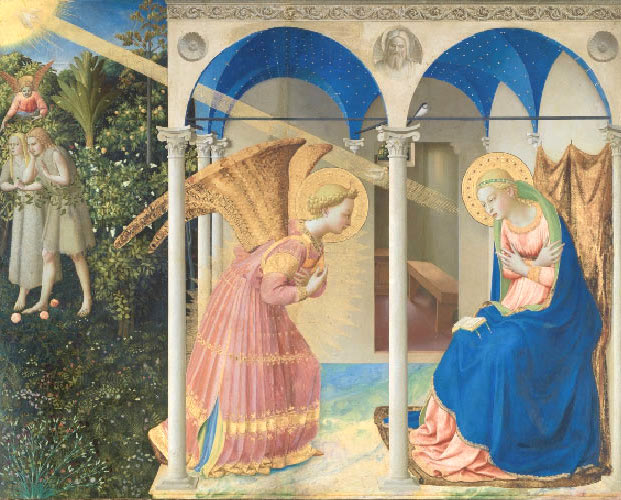
His brother Dominicans saw it as they walked up a flight of stairs, illuminated by light from a window out of view. It would be as if you could walk into another world, which is somehow our world too. Fra Angelico has cast the scene both indoors and outdoors. Mary is seated on a "throne" which is a mere wooden stool, as befitting her humility. Her robe is a royal blue — a rich color, if you have to crush lapis lazuli to powder to make it. She is seated in a porch, its roof held up by Corinthian columns and gently pointed arches. We are to think of a palace, and of the Greek and Roman world into which the Church is about to be born.
Gabriel approaches her, dramatically, one of his wings partly hidden by a column. This is an event, happening in time and space. He leans forward in an attitude of honor, arms folded over his breast. Mary leans forward in the same posture. It's the moment when she says, Fiat mihi, and the Word is made flesh and dwells among us. How can that be, as she does not know man? There's a small window in the wall of the porch, between the angel and Mary. In it you can see reflected the nearby garden. But you might also think: just as light can pass through the glass of a window, the window remaining intact, so did the Holy Spirit make fruitful the womb of Mary, preserving her virginity.
To the left of Gabriel we see a garden stippled with white flowers, surrounded by a lowly wooden stockade fence, with nail-holes in each of the uprights. Why a garden? Fra Angelico is thinking of the verse from the Song of Songs, spoken by the bridegroom about the bride: My beloved is a garden enclosed (4:12), a garden of fragrant spices and fruit. We're meant to think of that other garden whence man was driven in punishment for his disobedience. A greater garden by far, a more glorious land of delight awaits us, be cause Mary has turned the key in the gate. Where that final garden is, we can guess from the colors in Gabriel's wings, the colors of the rainbow. He is a herald sent from heaven.
Every stroke is delicate and deliberate; deep peace pervades the whole. The painting is meant for wonder and which I will translate:
When you pass by the figure of the Virgin unbroken,
Take care lest you keep silent, and not cry out, Hail!
Whiter than snow
The second is his Harrowing of Hell.
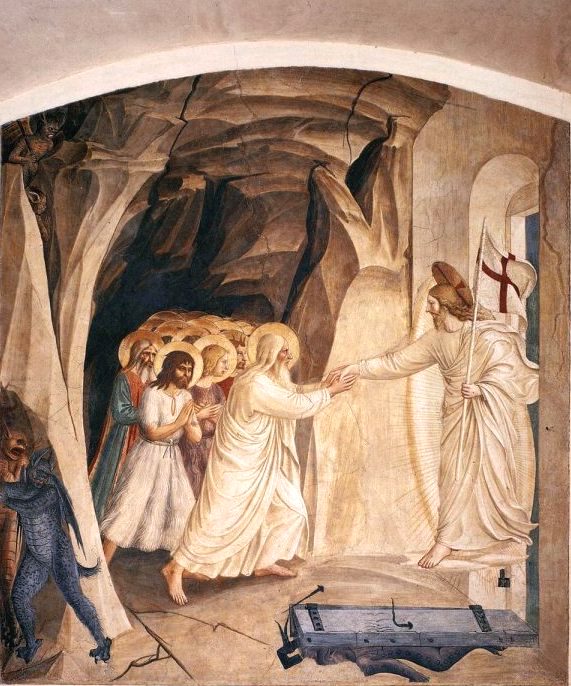
Fra Angelico is the only painter I know who could paint white upon white, and make it seem as if the very robes were alive. The chief color in the scene is white, white against the plaster of Saint Mark's spare walls. Christ is robed in white, carrying his triumphant banner, a red cross on a white ground. All the accoutrements of hell are dull and trivial by comparison: the iron door at the Lord's feet, with a black devil squashed beneath it like an unpleasant bug; a couple of cowering demons to the left; and the dim mouth of the cave within.
But in front, in blessedness, what a scene! Jesus leans forward with a welcoming hand, as a very old man all in white, with long white hair and a white beard, races toward him — you can feel how eager he is! That is our ancient father Adam, the old man redeemed by the new Man, and sure enough he does resemble Jesus. Behind Adam rushes a crowd of souls, each graced as Adam is with a golden halo. We can see the faces of four. One is Eve, who looks like Mary in the Annunciation, with her hands crossed upon her breast. Another, whom Jesus called the "greatest born of woman," is the Baptist, shaggy and robust, his hands folded in prayer. Another is Aaron, robed as a priest. The fourth, to my eye, appears to be crowned. That would be David. And so we have Christ, priest and prophet and king, redeeming priest and prophet and king, and summing them all in himself.
Painting like a child
Now I come to his Last Judgment, a magnificent small altarpiece, like a box of jewels.
It's said that Fra Angelico first learned his trade by illuminating manuscripts, and sure enough, that care for the tiny detail is everywhere evident in his work. Here you see the saints in glory, their eyes raised to their Redeemer, or looking upon one another with joy and love. I know of no artist, not even Michelangelo, who seems to have felt so keenly that Jesus came to save this man, utterly unique, and that woman, utterly unique; no artist who knew as well as Fra Angelico that holiness makes us more distinct, more ourselves, and more fit for communion and friendship. You see a boyish soldier — George? A thoughtful queen — Margaret? A triple-tiara'd pope who cannot hold himself back — Gregory the Great? And, of course, Dominic, and Thomas Aquinas, and Catherine of Siena. They have to be there.
He was sought after, and could command a high price for his work, but he never did. "You have real wealth," he said, "if you are content with little."
But what delights me most about this vision of glory is the scene to the left of the saints. It's another garden, with a palm tree growing up in the middle, and a circle of angels and children, dancing hand in hand. There was always something sweet and childlike about Fra Angelico and his art, and we recall the words of Christ, that if we want to enter the kingdom of heaven, we must become as little children. There's an old Italian song that is fitting here, which I'll render into English:
A garden blooms in heaven above
Where all the blessed, in a ring,
Their hearts aflame with holy love,
Return the love, and dance and sing.
So every saint a-caroling goes
With every angel in the reel,
Dancing before the heavenly Spouse
For love that they alone shall feel.
 This is Meaghen Gonzalez, Editor of CERC. I hope you appreciated this piece. We curate these articles especially for believers like you.
This is Meaghen Gonzalez, Editor of CERC. I hope you appreciated this piece. We curate these articles especially for believers like you.
Please show your appreciation by making a $3 donation. CERC is entirely reader supported.

Acknowledgement
 Anthony Esolen. "How the Church Has Changed the World: A Ring of Joy." Magnificat (May, 2021).
Anthony Esolen. "How the Church Has Changed the World: A Ring of Joy." Magnificat (May, 2021).
Join the worldwide Magnificat family by subscribing now: Your prayer life will never be the same!
To read Professor Esolen's work each month in Magnificat, along with daily Mass texts, other fine essays, art commentaries, meditations, and daily prayers inspired by the Liturgy of the Hours, visit www.magnificat.com to subscribe or to request a complimentary copy.
The Author
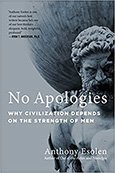
Anthony Esolen is writer-in-residence at Magdalen College of the Liberal Arts and serves on the Catholic Resource Education Center's advisory board. His newest book is "No Apologies: Why Civilization Depends on the Strength of Men." You can read his new Substack magazine at Word and Song, which in addition to free content will have podcasts and poetry readings for subscribers.
Copyright © 2021 Magnificat


